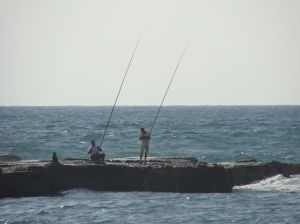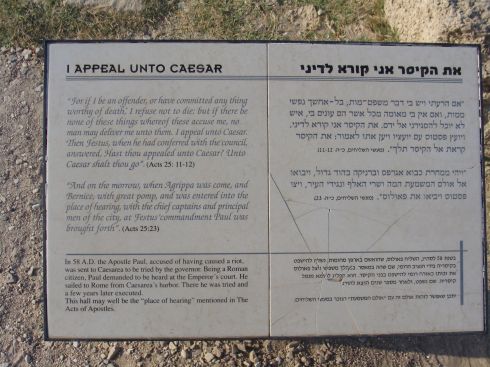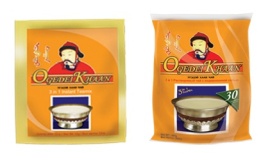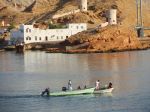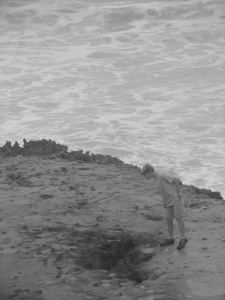While staying in Khartoum last year the lobby of my hotel was liberally sprinkled with very nice oil paintings, all floor-mounted like some sort of temporary bazaar, though without the artist there personally hawking his wares.
The particular piece below intrigued me more than any other and I stopped in front of it at least four or five separate times, contemplating it as a purchase — how to ship it back to Oman, whether the meagre price of $300 justified it (certainly, in retrospect, the price seems right!) — and contemplating also, at the same time, though more subliminally, the reasons I felt so drawn to it. In the end I merely took a picture of it, wanting to look at it again in the future, like now. Perhaps, during this coming summer, I’ll try my hand at painting a version of it myself (though in acrylics rather than the touchier, more drawn-out oils). For now, I find it interesting to once more look at it and, having gained a bit of time and distance for self-study and for processing the experience of Sudan, I’d like to list the reasons (some of them NQR) that this particular image engrosses me.

Oil painting of a Sudanese market.
Reasons I like this painting:
1. Color scheme — First, and most obvious from a distance, the color-scheme is a cooling one. It contrasts markedly against the actual experience of Sudan, which is (or was for me) one of incredible bustle, dust, noise, and heat. As such, this scene reveals the artist’s fantasy of what Sudan should be, not what it actually is. Perhaps that is the primary attraction for me, a romanticized, Oriental idea of what Sudan might be. On the other hand, just maybe on some perfect spring or winter evening with the light diminished, slanting through massed urbanity, a person might actually witness these shades. Also, beneath the purples and blues and blacks, a latent heat remains, or I am reminded of this heat’s presence by the very fact of its absence, like a heart grown suddenly fond of what it would, when subjected to full and direct confrontation, undoubtedly consider a blinding and hurtful truth.
2. Perspective — The thoroughfare in the foreground spreads horizontally while the maze of the market, the depths of the market, open with the single focus of a grade-schooler’s first attempts at perspective art, buildings getting smaller, smaller, as they recede toward a central vanishing point, people reduced in the crowd to heads and shoulders and shapes that subjectively might mean ‘human’ or ’emptiness’ or ‘wall’ depending on the way the eye sees each particular blotch of color, each shape and thrust of flattened object. This again brings me toward the Orientalist fantasy of standing outside yet being permitted to gaze at the interior, to wander the maze, to drown oneself in the thriving exotica of a place ultimately foreign. It is voyeurism taken to a second remove, the first being the situation of the canvas vis-a-vis the captured scene, outside the market; the second being the even more comfortable distance between viewing art and standing in actual living reality in such a scene, having that scene transformed, robbed of its grosser sounds and visions, simplified, idealized.
3. Homogeneity / Anonymity — The people are faceless. The buidlings largely nondescript. And each of these, building or human, seems constructed on a theme, of one part, one mold, variation but only within defined parameters. In truth, Sudan (and Khartoum especially) vibrate with advertising, with striving, with differentiation, everything from Bob Marley t-shirts to traditional dishdashas like those the people in this market painting wear. Does such a market actually exist, still devoid (or ever devoid) of the capitalist slogan, the Coca-Cola sign, the Marlboro horseman, the vendor calling out to each pedestrian so that he might sell his kebabs, his falafel, his magazines, his boxes of cheap tissue? With the self so foremost in every Western mind, the idea of this anonymity is yet another fantasy: who am I to think myself different, unique, and better?
4. Shadow — This might have been the first thing to draw me to the photo. The short shadows at the feet of the marketgoers. They speak to a noonday business, to heat, betraying heat despite the change of the color to purple and black. The shadows quaver on the ground. They seem to move, illusions, mirages. And the dusty ground drinks each shadow into itself, not letting it spill further than a few feet, not letting it spread a black and definite edge to the height of the shadow-maker’s head. A sense of comfort hides in these shadows, so different than the Western mentality, which wants nothing to be left mysterious, everything to be exposed to the glare of science. The Arabic expression itself, which is — contrary to our version of “Shed some light on the subject” — usually rendered “In the shade of that . . .” speaks to this altered perception of shade=good, sun=bad; secrets=good, too-much-truth=bad, dangerous, and absent of the very stuff that makes life worth living — surprise, serendipity, mystery, awe, love, abode.
5. Texture — The whole paiting has a smoothness to it, empty planes, empty shapes that slide one into another. Yet there is another texture at work too, on the edges, the faces of the buildings. This texture nods toward Klimt, enlivening while also reducing the buildings to abstractions, to canvasses themselves, to dreams. These textures capture dirt, graffiti, mildew, and decay and turn them into art, which is, I believe, a higher purpose for the artist, to ennoble sight, to turn sight into a better seeing. It makes me take a step back, when I recoil at an old and worn-out metropolitan’ filth, to see in it the marks of so many people, incessantly worrying, hurrying, to-ing and fro-ing, but in art made still and made to behave as if each mark of passage has become a hieroglyph, a telltale sign, a signature, a sweetness. These textures occur on the edges of the painting, leaving the inside, the maze, pure and empty, an unwritten page for the mind’s eye.
I could look at this painting all day, which is a criterion for greatness in my book. All its portions of NQR — the fantasy, the unreality, the untruth — add up to a whole for me far greater than any one individual lie.
